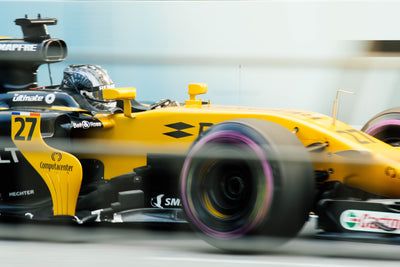On all US Domestic orders.

Unleashing Speed: The Science of Racing Tires
When it comes to motorsports, the rubber meeting the road isn't just a poetic phrase; it's a profound science. Racing tires are not the same as your standard road tires—they are precision-engineered pieces of technology that play a pivotal role in determining a race car's performance.
In this blog, we'll delve into the fascinating world of racing tires, exploring the science behind their compounds, tread patterns, and the crucial impact they have on grip and overall performance on the track.
The Chemistry of Grip: Compounds and Construction
Racing tires are crafted from unique rubber compounds, customized to deliver optimal grip. These compounds are softer than typical road tire rubber, ensuring they grip the track tightly. However, they wear out faster, which is a trade-off for improved performance.
The internal structure of racing tires is equally vital. It consists of layers of fabric and steel belts that provide rigidity and stability. This is essential for maintaining the tire's shape during high-speed cornering.
The Art of Tread Patterns
Slick racing tires have no tread patterns. Instead, the entire surface contacts the track, maximizing grip on dry surfaces. However, they are ineffective in wet conditions as they can't displace water effectively.
Grooved tires with strategically designed tread patterns are ideal for wet conditions. They channel water away from the tire, reducing the risk of hydroplaning. The size and shape of the grooves are carefully engineered for specific track conditions.

Tire Temperature and Pressure
The grip of a racing tire is highly dependent on temperature. Cold tires are less adhesive, while overly hot tires tend to become too soft and can lose grip. Maintaining the optimal operating temperature range is crucial.
Proper tire pressure is essential. It affects the size of the tire's contact patch with the track. Both overinflated and underinflated tires can lead to decreased performance. Teams meticulously adjust the pressure to suit track conditions and driving styles.
Cornering Forces and Grip
Racing tires must contend with tremendous lateral forces as vehicles take corners at high speeds. The tire's grip is what allows the car to navigate these corners without sliding out of control. Acceleration and braking exert longitudinal forces on the tires. Traction is vital to ensure that the tires grip the track and maximize performance during acceleration and deceleration.
Improving Lap Times with Racing Tires
Effective tire management is essential. This means finding the right balance between pushing the tires to their limits and preserving their life over an entire race. Racing tires need to deliver consistent performance throughout a race. Sudden drops in grip can spell disaster for a racer's lap times and overall performance.
As we uncover the science behind racing tires, it's apparent that they're not just black, round pieces of rubber. They're the result of extensive research, engineering, and precise construction. If you're an aspiring racer or a seasoned pro, you understand the significance of having the right racing tires under your car.
Besides racing tires, you also need to have the right equipment, such as race helmets, gloves, racing suits, shoes, etc., to perform at your absolute best. If you are ready to explore the world of cutting-edge racing gear, visit Fast Racer today to discover a premium selection of equipment. Elevate your racing experience with safety and performance in mind. Don't compromise—gear up with Fast Racer.


Leave a comment